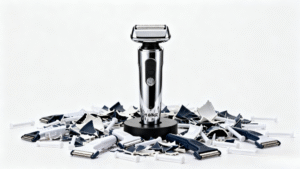For decades, the personal care aisle has been a world of stark contrasts: dark, aggressive packaging on the “men’s” side; soft, pastel tones on the “women’s.” But as we head into 2026, those lines are not just blurring—they are being erased by a new generation of consumers.
The move towards inclusive grooming is no longer a niche conversation among progressive startups; it has become the single most significant and commercially powerful growth driver in the entire personal care industry. This is not merely a fleeting social trend; it’s a fundamental market shift. This report will analyze the forces behind this revolution, what it looks like in practice, and provide a strategic guide for brands and manufacturers to capitalize on this immense opportunity.
1.Women’s body groomer: Drivers Behind the Inclusive Grooming Trend
To understand where the market is going, we must first understand the forces pushing it there. This isn’t happening in a vacuum; it’s the result of powerful demographic and cultural shifts.
- The Gen Z Revolution (Gen Z consumer behavior): The most diverse and digitally native generation in history, Gen Z, rejects rigid labels. They value authenticity, self-expression, and brand transparency above all else. They don’t shop based on gendered marketing cues; they shop for products that work and brands that align with their inclusive worldview. For them, grooming is a form of personal expression, not a gendered obligation.
- The Wellness Wave: The definition of “grooming” has expanded. It’s no longer just about hair removal; it’s an integral part of a holistic wellness and self-care routine. This wellness-focused approach transcends gender. Consumers of all identities are seeking tools that help them feel good in their own skin, making the old gendered segmentation feel outdated and irrelevant.
- The Awakening to an Untapped Market: For years, the market for the women’s body groomer was an afterthought, often addressed with a “pink it and shrink it” strategy—taking a men’s product and simply changing its color. Brands are now awakening to the reality that this is a massive, underserved market hungry for products designed with their specific needs and ergonomics in mind. This represents a colossal opportunity for target audience expansion.

2. Women’s body groomer: The “What”: Inclusive Grooming in Practice
So, what does inclusive grooming actually look like on the shelf and in a marketing campaign? It’s a top-to-bottom rethinking of product and communication, moving from stereotypes to universal appeal. Gender-neutral grooming products are not about being bland; they are about being thoughtfully designed for a wider audience.
The difference between the old and new approach is striking:
| Aspect | Old Approach (Traditional) | New Approach (Inclusive) |
| Product Design | “For Men” branding, aggressive/bulky design, dark colors (black/blue). | Function-first design, ergonomic for various hands, neutral palettes (graphite, white, sage). |
| Packaging | Gender-specific imagery and language. | Minimalist, clean design. Focus on benefits and ingredients, not gender. |
| Marketing Language | “Unleash the beast,” “For the modern man.” | “For every body,” “Personal care, simplified,” “Grooming for all genders.” |
| Visuals/Imagery | Primarily features stereotypical male models. | Features a diverse cast of models representing different genders, body types, and skin tones. |
Essentially, the new strategy is to trust your customer. Instead of telling them who the product is for, you show them what the product does, and let them decide if it’s right for them. This requires confidence in your product’s performance and a genuine commitment to an inclusive marketing strategy.

3.Women’s body groomer: A B2B Guide to Winning in an Inclusive Market
Understanding the trend is one thing; capitalizing on it is another. For manufacturers, product developers, and brand managers, here are actionable strategies to implement.
For Product Design & Manufacturing: The focus must shift to inclusive product design. This means:
- Ergonomics for All: Conduct user research with a truly diverse group of people. Test for different hand sizes, grip styles, and use cases. A product that is comfortable for a wider range of people is inherently more valuable.
- Universal Aesthetics: Move away from traditionally masculine or feminine color palettes. Embrace sophisticated, neutral tones like graphite, silver, cream, beige, and sage green that have broad appeal. Focus on high-quality materials and finishes.
- Functional Modularity: Develop modular systems. A single base unit with interchangeable heads (e.g., a trimmer for body, a foil shaver for smoothness, a precision detailer for face) allows users to build a personalized toolkit that suits their individual needs, regardless of gender.
For Brand & Marketing Management: This trend requires a complete rethink of your market diversification strategy.
- Shift Your Messaging: Your copy should focus on benefits, not identity. Instead of “The best trimmer for men,” try “The best trimmer for a close, comfortable shave.” Talk about results (smooth skin, no irritation) and features (waterproof, long battery life).
- Authentic Representation: Your visual identity must reflect the diversity you wish to attract. Feature models of all genders, ethnicities, body types, and abilities in your campaigns. Authenticity is key; tokenism will be spotted and rejected.
- Community & Collaboration: Partner with a diverse range of influencers and creators who can genuinely speak to how your product fits into their lives. Build a community that celebrates self-care and individuality in all its forms.

4. Women’s body groomer: How Inclusivity Reshapes the Shopping Experience
The trend towards inclusive grooming doesn’t stop with the product or its marketing; it extends all the way to the point of sale. The traditional, strictly segregated retail environment is becoming a major friction point for the modern consumer. For brands and manufacturers, understanding this shift in the retail landscape is crucial for securing placement and driving sales.
- The Breakdown of the “Grooming Aisle”: Physical retailers are beginning to dismantle the classic “men’s grooming” section. Instead, we are seeing the rise of solution-oriented merchandising. Products are being categorized by function (e.g., “Shave & Trim,” “Skin Care,” “Hair Care”) or by concern (e.g., “Sensitive Skin Solutions”), rather than by gender. This means your product‘s packaging and on-shelf presence must communicate its purpose clearly without relying on gendered cues.
- Digital Merchandising and User Experience: On e-commerce sites and brand websites, this trend is even more pronounced. Navigation and filtering options need to evolve. Instead of forcing a user to choose “Men” or “Women” at the start of their journey, best-in-class websites now allow users to shop by product type, body part, or specific need. This omnichannel retail consistency is key to providing a seamless and welcoming shopping experience for everyone.
B2B Implication: When designing your product packaging, consider its “shelf-agnostic” appeal. It needs to stand out in a potentially gender-neutral retail environment. Furthermore, when pitching to retailers, showcasing your brand’s understanding of inclusive marketing and merchandising can be a powerful differentiator, proving you are a forward-thinking partner who can help them attract a modern, diverse customer base.

5. Women’s body groomer: The Challenge of Authenticity and Avoiding “Inclusivity-Washing”
As inclusivity becomes a mainstream expectation, a new challenge arises for brands: the risk of “inclusivity-washing” (or “woke-washing”). This refers to the practice of using inclusive marketing messaging as a superficial tactic without any genuine commitment to the values being promoted. Today’s consumers, especially Gen Z consumer behavior, are incredibly adept at spotting inauthenticity, and the backlash can be damaging to a brand’s reputation.
- Authenticity Must Be End-to-End: True inclusivity isn’t just a marketing campaign; it’s a business philosophy. It needs to be reflected across the entire organization. Does your product development team include diverse voices? Does your leadership team champion these values? Launching a gender-neutral grooming product while maintaining a homogenous corporate culture sends a conflicting and inauthentic message.
- Action Over Words: Consumers want to see brands take tangible action. This could mean partnering with non-profits that support LGBTQ+ or other minority communities, ensuring fair labor practices throughout your supply chain, or actively seeking out and amplifying diverse voices within your own content platforms. A one-off campaign during Pride Month is no longer enough; consumers expect a year-round commitment.
B2B Implication: For manufacturers, this means being prepared to answer deeper questions from brand partners about your own company’s diversity, ethics, and labor practices. For brands, it means the work of building an inclusive brand starts from within. The most successful brands in this new era will be those whose marketing is a genuine reflection of their internal culture and values. This is the ultimate barrier to entry and the most defensible long-term competitive advantage.






